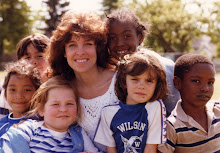It took a few weeks to learn the routines--washing hands, moving quickly through the long lunch lines, turning in their lunch cards--but soon they had them down. In the meantime, I had also learned their names. One day I mentioned to darling Catherine that my name was also Kathryn, and thus began the spontaneous choruses of, "Kathryn, sit here!" "No, sit here!" "Hi, Kathryn!"
I also come with a healthy tolerance for spilled milk--opening those cartoons is a bear--and reminders to try the overcooked main courses and naked vegetables slices. Sadly, their diverse palates--as diverse as their names--frequently turn away the cafeteria fare, even with its healthier whole wheat breads and daily veggies and fruit servings. My sadness at watching the waste is palpable, and I also worry about kids getting through a day of learning on a few crackers and half a carton of milk.
So I started bringing in apples. I'd bought a case of a beautiful heirloom variety--Tsugaru--after it was voted the favorite at a local farmers market tasting. Every day I top off my lunch bag with 4-5 apples, drag along a cutting board and knife, and the kids inhale them! If they ask, I cut up the little lunch apples, too. The kids' fruit quotient soon doubled, and soars if I sit down to eat with them! I watched Jefferson eat fruit for the first time--a kid who one day drank a few sips of milk and ate the contents of a ketsup packet. With his forefinger.
To be fair, they always eat the bananas, even when they're green.
Today I brought a head of romaine. One by one I pulled the beautiful leaves from a ziplock bag, dipped
 them into a little cup of ranch dressing, and commented that I like my lettu
them into a little cup of ranch dressing, and commented that I like my lettu ce leaves whole. And one by one they followed my lead into their own little dressing cups. This time I watched Jefferson eat a vegetable for the first time, tearing his leaves into little dip-size pieces. The entire head of lettuce was gone in 5 minutes.
ce leaves whole. And one by one they followed my lead into their own little dressing cups. This time I watched Jefferson eat a vegetable for the first time, tearing his leaves into little dip-size pieces. The entire head of lettuce was gone in 5 minutes.All the while, the kids were playing their new game of switching seats. "I'm the new Ralph!" "I'm the new Eduardo!" "I'm the new Jessica!" "I'm the new Mussie!" "Kathryn, sit here!" I shagged them back to their seats, chuckling at their ingenuity.
I think I've figured it out: Good food, good company, a few surprises.



